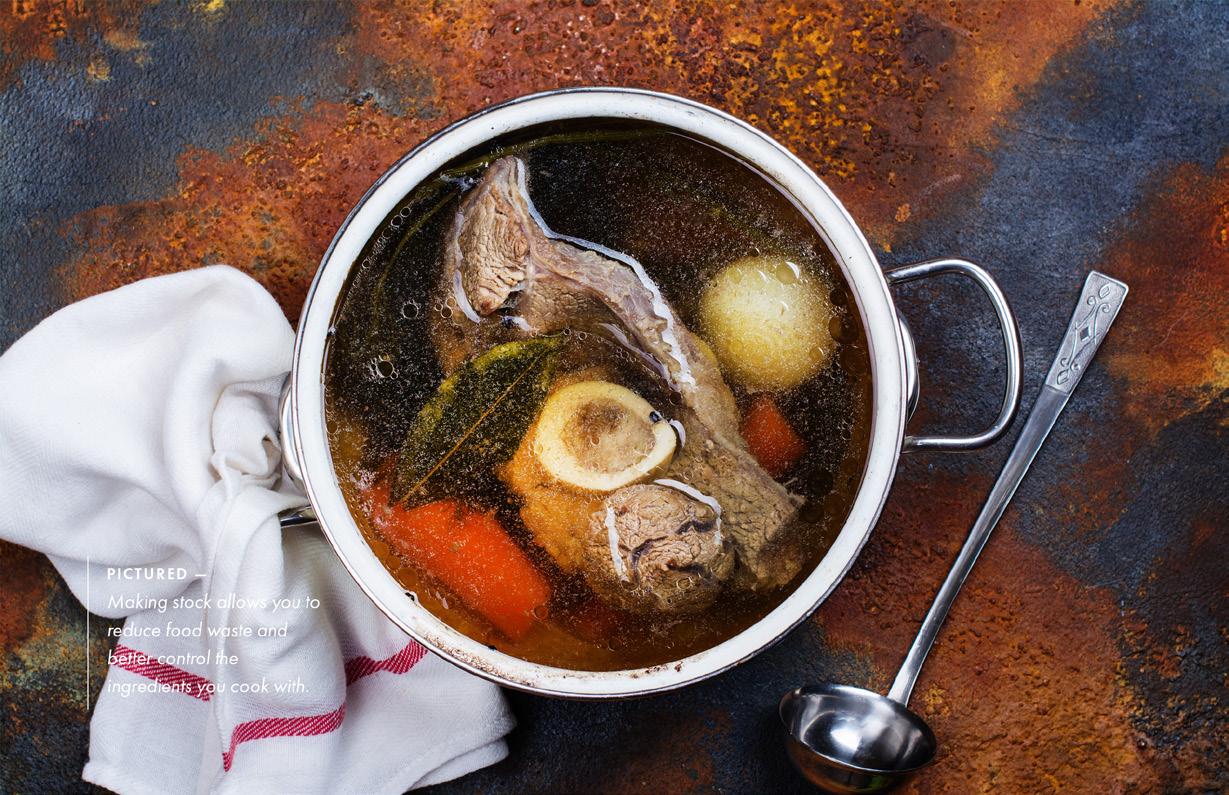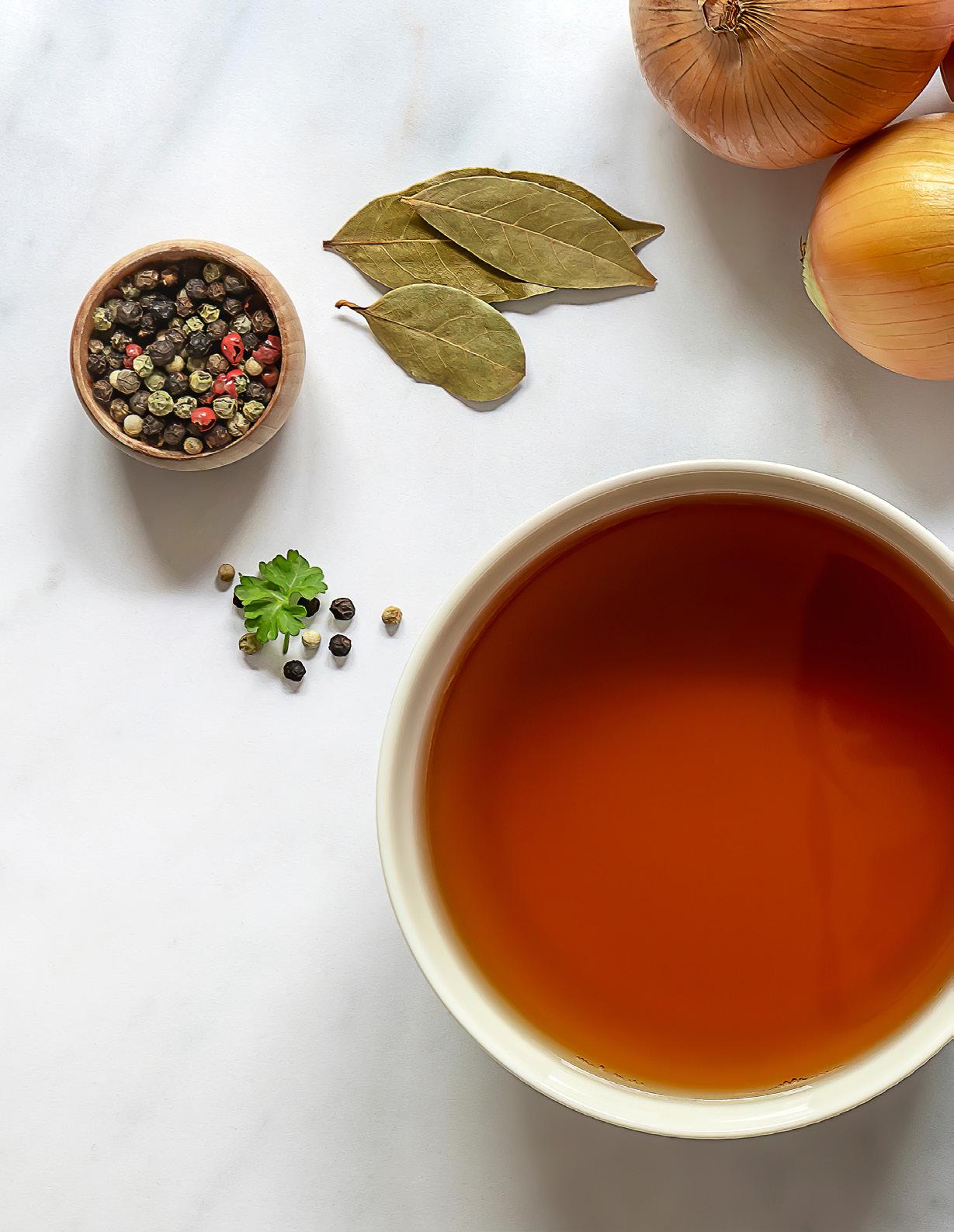
5 minute read
STOCK 101: BONES, BROTH & BEYOND
By: Chef Kendra
If you watch our YouTube channel, you may have noticed that a common ingredient in our recipes is stock. At a very basic level, stock is a savory, flavorful cooking liquid used as a base ingredient for soups, stews, braises, and sauces, and is derived from meat, poultry, fish, game, or vegetables with aromatics and herbs.
Advertisement
Stock is an ancient, beloved ingredient used by home cooks and professional chefs to build body, increase volume, and create umami in recipes. Using the right stock at the right time—whether store bought or homemade—can make all the difference in a dish.
However, what exactly is stock? Is it the same as broth? What are the benefits? Where does it come from? And, most importantly, why should we use it? The pages that follow bring you deeper into what we consider “liquid gold.” Much more than simmering kitchen scraps, stock is a lesson in history, geography, science, nutrition, and more.
THE STORY OF STOCK —
Like most dishes, the story of where stock originates is highly debatable as all cultures can easily claim some form of this long simmered, flavorful liquid as their own. In Italy, it’s brodo. In France, it’s bouillon. In Vietnam, it’s canh. In Mexico, it’s caldo. It is, however, widely accepted that stock was more than likely invented along with the discovery of fire and was used as a way for humans to squeeze every last calorie from an animal (in turn making bone broth a crucial part of today’s popular Paleo Diet). But the French can be credited for taking hold of stock — formalizing it, refining it, defining it, and applying it to cooking methods making it the base of flavor development for a wide variety of dishes. Today, we appreciate the standardization of stock and also the window of creative liberty it has opened.
Watch our video and follow my instruction as I demonstrate how to prepare two classic stocks.
— Chef Kendra
Bete’avon ! — Bon Appétit !
Brown Stock Watch Now!
NUTRITIONAL BENEFITS —
There are countless nutritional benefits of stock and bone broth which is why it is often referred to as “liquid gold.” The bones and connective tissue of all animals are made up of nutrients such as collagen. As the most abundant protein in our body, collagen is the building block for our skin, muscles, bones, tendons, and ligaments. Consuming collagen rich foods, such as stock and bone broth, helps our body repair and grow. Additionally stock is packed with amino acids and minerals that aid with digestion and help reduce inflammation within our bodies among other healthful benefits.
White Stock Watch Now!
CONCENTRATION & WATER MANAGEMENT — I consider making a stock, a broth, a sauce, or anything to do with water, a dance. It’s a play in increasing and decreasing the volume of liquid to decrease and increase the concentration of flavor. Simply put: when you start a stock, it is typicallly a mess of ingredients covered in cool water; however, after hours of simmering over low heat, magic happens. The gentle heat coaxes the flavor and nutrients from your ingredients and as time goes by and water evaporates as steam, the flavors condense. And then something else happens, water evaporates and the flavors condense. And so the dance of flavor concentration begins! Each time you add water and then let it reduce by evaporating is what ultimately develops the intensity of flavor in your stock.

TYPES OF STOCK & THEIR USAGE —
There can be an overwhelming selection of stocks to choose from. Keep it simple: vegetarian or not, light or dark. Stock is derived from slowly simmering aromatics and herbs along with the bones of meat, poultry, fish, game, or can be completely vegetarian. The type of stock you use is determined by the recipe you are following and/or the outcome you are looking to achieve. A light (or white) stock, such as chicken or vegetable, is best for lighter dishes such as soups, rice or risotto, and some sauces. A dark (or brown) stock, such as beef, is best used for heavier stews, braises, and some sauces.
Pro Tips
from CHEF KENDRA
Stock Up!
If you are making your own stock (which we strongly encourage you to do) it will keep for up to six months in your freezer. We like to freeze our stocks in various amounts to help make prep a breeze. Whether you are freezing in quart containers or ice-cube trays, be sure to label your stocks with the type of stock it is and the date it was made.
Light & Dark StockS
—
Light (or white) stock is made by cooking all of the ingredients in water only. Dark (or brown) stock begins with caramelizing the aromatics among other additional ingredients.
Stock vs. Bone Broth

—
While stock and bone broth share many similarities, there are a few qualities that set the two apart. First, stock is primarily made using the bones only while bone broth will include the bones, connective tissue, and even some meat. Another difference is that stock will cook for anywhere from one to six hours, while a true bone broth can cook on a low simmer for up to two days.
Reduce Waste & Save Money
—
Stock is a great way to get the most of your groceries. Because the end result will be strained thoroughly, you can use the clean ends and peels of vegetables, stems of herbs, last drops of wine, and discarded bones from the butcher.

A Note On Veal Stock
If you are not yet familiar with veal stock, allow me to introduce you to it. While we regularly use and adore beef, chicken, and vegetable stock, we find veal stock—both white and brown—to be fabulously versatile. The guide that follows illustrates the similarities and differences between the two classic stocks. Watch my video tutorial on YouTube for more information.
Let’s get to it!
— Chef Kendra
pro tip Clean Your Bones
Bones naturally have impurities. You may have noticed if you’ve boiled bones in the past that a greyish foam accumulates at the top of your bubbling pot. That foam is the impurities releasing from the bones. While it is certainly safe to just skim the foam away while making your stock, “cleaning” the bones first will help render a clearer outcome. To do this, cover your bones in cold water and then bring this up to a boil for three to five minutes to release the impurities. Turn off the pot and then drain the bones and water over a colander in your sink. Be sure to rinse any residual foam from the bones before proceeding with your stock.
The Bones
—
BROWN STOCK — Roast your bones in the oven before building your stock.
WHITE STOCK — Clean your bones first by boiling them in water.
The Chop
—
BROWN STOCK — Aromatic ingredients should be prepared in a small, uniform dice. You’ll also need these extra ingredients: extra virgin olive oil, unsalted tomato paste, and dry red kosher wine (such as Cabernet Sauvignon).

WHITE STOCK — Aromatic ingredients can be prepared in larger, rougher cuts.

Pro Tips
Don’t Add Salt
Because you are essentially extracting and concentrating flavor, we strongly advise to not add salt when making your stock. Even the smallest amount of salt may seem harmless, but after several hours of cooking, it will increase in potency. Some recipes may call for salt but we recommend waiting until you are completely done making your stock—if at that point you taste it and it feels a little bland, then add some. But remember: once you add salt, you cannot take it out.
The cook —
BROWN STOCK — You’ll need to first caramelize your aromatics before building your stock.
WHITE STOCK — All of your ingredients can go in together at once.









